Contacts between the endoplasmic reticulum and other membranes in neurons
- PMID: 28559323
- PMCID: PMC5474793
- DOI: 10.1073/pnas.1701078114
Contacts between the endoplasmic reticulum and other membranes in neurons
Abstract
Close appositions between the membrane of the endoplasmic reticulum (ER) and other intracellular membranes have important functions in cell physiology. These include lipid homeostasis, regulation of Ca2+ dynamics, and control of organelle biogenesis and dynamics. Although these membrane contacts have previously been observed in neurons, their distribution and abundance have not been systematically analyzed. Here, we have used focused ion beam-scanning electron microscopy to generate 3D reconstructions of intracellular organelles and their membrane appositions involving the ER (distance ≤30 nm) in different neuronal compartments. ER-plasma membrane (PM) contacts were particularly abundant in cell bodies, with large, flat ER cisternae apposed to the PM, sometimes with a notably narrow lumen (thin ER). Smaller ER-PM contacts occurred throughout dendrites, axons, and in axon terminals. ER contacts with mitochondria were abundant in all compartments, with the ER often forming a network that embraced mitochondria. Small focal contacts were also observed with tubulovesicular structures, likely to be endosomes, and with sparse multivesicular bodies and lysosomes found in our reconstructions. Our study provides an anatomical reference for interpreting information about interorganelle communication in neurons emerging from functional and biochemical studies.
Keywords: FIB-SEM; Stim1; spine apparatus; subsurface cisternae; thin ER.
Conflict of interest statement
The authors declare no conflict of interest.
Figures

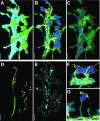
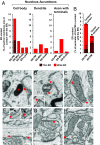

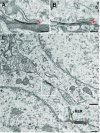
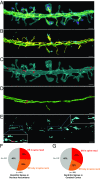
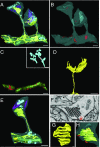
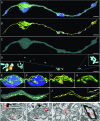

Similar articles
-
The neuronal endoplasmic reticulum: its cytochemistry and contribution to the endomembrane system. I. Cell bodies and dendrites.J Histochem Cytochem. 1983 Sep;31(9):1077-88. doi: 10.1177/31.9.6309951. J Histochem Cytochem. 1983. PMID: 6309951
-
Three-dimensional architecture of extended synaptotagmin-mediated endoplasmic reticulum-plasma membrane contact sites.Proc Natl Acad Sci U S A. 2015 Apr 21;112(16):E2004-13. doi: 10.1073/pnas.1503191112. Epub 2015 Mar 18. Proc Natl Acad Sci U S A. 2015. PMID: 25787254 Free PMC article.
-
Three-dimensional ATUM-SEM reconstruction and analysis of hepatic endoplasmic reticulum‒organelle interactions.J Mol Cell Biol. 2021 Dec 6;13(9):636-645. doi: 10.1093/jmcb/mjab032. J Mol Cell Biol. 2021. PMID: 34048584 Free PMC article.
-
Organization and function of membrane contact sites.Biochim Biophys Acta. 2013 Nov;1833(11):2526-41. doi: 10.1016/j.bbamcr.2013.01.028. Epub 2013 Feb 1. Biochim Biophys Acta. 2013. PMID: 23380708 Review.
-
New insights into the regulation of synaptic transmission and plasticity by the endoplasmic reticulum and its membrane contacts.Proc Jpn Acad Ser B Phys Biol Sci. 2021;97(10):559-572. doi: 10.2183/pjab.97.028. Proc Jpn Acad Ser B Phys Biol Sci. 2021. PMID: 34897182 Free PMC article. Review.
Cited by
-
Imaging interorganelle contacts at a glance.J Cell Sci. 2024 Oct 15;137(20):jcs262020. doi: 10.1242/jcs.262020. Epub 2024 Oct 23. J Cell Sci. 2024. PMID: 39440475 Review.
-
Presynaptic store-operated Ca2+ entry drives excitatory spontaneous neurotransmission and augments endoplasmic reticulum stress.Neuron. 2021 Apr 21;109(8):1314-1332.e5. doi: 10.1016/j.neuron.2021.02.023. Epub 2021 Mar 11. Neuron. 2021. PMID: 33711258 Free PMC article.
-
Handling heme: The mechanisms underlying the movement of heme within and between cells.Free Radic Biol Med. 2019 Mar;133:88-100. doi: 10.1016/j.freeradbiomed.2018.08.005. Epub 2018 Aug 6. Free Radic Biol Med. 2019. PMID: 30092350 Free PMC article. Review.
-
Presynaptic endoplasmic reticulum and neurotransmission.Cell Calcium. 2020 Jan;85:102133. doi: 10.1016/j.ceca.2019.102133. Epub 2019 Nov 27. Cell Calcium. 2020. PMID: 31812114 Free PMC article. Review.
-
Enforced tethering elongates the cortical endoplasmic reticulum and limits store-operated Ca2+ entry.J Cell Sci. 2022 Mar 15;135(6):jcs259313. doi: 10.1242/jcs.259313. Epub 2022 Mar 30. J Cell Sci. 2022. PMID: 35191477 Free PMC article.
References
Publication types
MeSH terms
Grants and funding
LinkOut - more resources
Full Text Sources
Other Literature Sources
Miscellaneous

